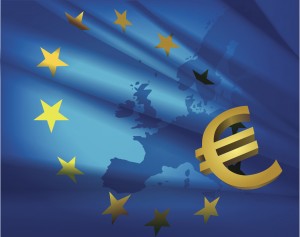 By Gary Smith
By Gary Smith
Euro forecast: popular currency pairs under the spotlight
 The bulk of recent euro-related commentary has centered around the likelihood of Brexit. Uncertainty about the outcome of the referendum coupled with pessimistic predictions about the implications of Brexit have set the pound on a downward trajectory against the euro. But Brexit aside, how is the eurozone faring? How is the euro performing against other commonly-traded currencies? We take a look.
The bulk of recent euro-related commentary has centered around the likelihood of Brexit. Uncertainty about the outcome of the referendum coupled with pessimistic predictions about the implications of Brexit have set the pound on a downward trajectory against the euro. But Brexit aside, how is the eurozone faring? How is the euro performing against other commonly-traded currencies? We take a look.
The Eurozone at a glance
Recent data releases help to illustrate the eurozone’s current state of health, and highlight the challenges on the horizon…
GDP outlook. The eurozone economy as a whole grew 1.5% in 2015. The fourth quarter had seen growth of 0.3%, unchanged on the previous quarter, but down on the 0.4% and 0.6% increases in the first and second quarters respectively. Growth is slowing, due in large part to weak global demand. The European Central Bank (ECB) has recently cut its growth forecast for 2016 and 2017 to 1.4% and 1.7%, (down from 1.7% and 1.4%). The start of April also saw the release of jobs figures suggesting a modest improvement in the eurozone’s unemployment rate.
Inflation. The eurozone is teetering close to a deflationary situation. The ECB’s Inflation estimate for this year is just 0.1%, with a projection of 1.3% for 2017. In part, this is driven by low oil prices. The ECB’s target inflation rate is 2%. The fact that we are so far away from that target is a key reason why interest rate increases remain such a distant prospect.
Stimulus. In March, the ECB cut interest rates from 0.5% to zero, as part of a package to revive lending and stimulate activity. Initially, this announcement caused an immediate plunge in the value of the euro. It rallied, however, when ECB president Mario Draghi stated that he did not anticipate pushing the rate into negative territory.
In short, traders should pay special attention for evidence of the following as triggers of negative sentiment against the euro:
- further downwards revisions of GDP growth for the coming year
- Inflation turning into deflation
- Any suggestion that the present stimulus measures are not enough – in which case, a negative interest rate could be on the cards for the euro
EUR/USD
The EUR/USD rate has been fluctuating between 1.08 and 1.14 since the turn of the year. Whereas interest rates have flatlined at the zero mark in the eurozone, the big driver of the dollar’s strength remains the possibility of rate rises.
The US is currently outperforming the eurozone and other key markets. Back in December, the Fed raised interest rates for first time since 2006, causing a surge in support for the dollar. If all goes to plan, Fed Chair Janet Yellen intends to follow up with two further rate rises, potentially taking the federal funds rate to 1%. So the question is whether the US economy is strong enough to stomach rate rises. Recent employment figures bode well: 200,000 new jobs were created in all but three of the last 12 months – and 215,000 jobs were created in March.
But global headwinds remain strong. Just 42% of traders now think a rate rise is likely in June. Goldman remains bullish on the dollar: it takes the view that the economy has weathered the December increase well, and suggests that the currency could appreciate 15% over the next 12 months.
If June comes and goes without a rate rise, expect the euro to pick up support (or at least remain steady). If a rate rise is announced, expect an immediate fall in value against the dollar.
EUR/AUD
The EUR/AUD rate peaked at close to 1.60 in February. An Aussie dollar rally means that the euro has leaked around 15 cents. For the Aussie, performance is linked closely to figures from China and the implications this has for Australia’s commodities and industrials sectors. Stronger than expected numbers from China coupled with encouraging local jobs figures are thought to be behind the rally.
So will it last? The signs are good. Policymakers were aiming for a ‘soft landing’ in the face of the commodity prices collapse. The indications are that this approach may be working.
EUR/YEN
Since the start of the year, the yen has gained more than 10 percent against the dollar and has made similar gains against the euro. Japanese Cabinet Office data released in April demonstrated that the country’s manufacturing sector is still struggling, with orders falling 30.6 percent in February, marking the largest single decline on record. In January, the Bank of Japan introduced negative interest rates in an attempt to boost competitiveness and encourage business lending.
The problem for Japanese policymakers is that the yen is currently seen as a ‘safe haven’ by currency traders. However, there’s a strong suggestion that this rally is about to come to an end. Slowing growth rates across Asia combined with the effect of negative interest rates has led Goldman to predict a 14 percent plunge in the yen over the next 12 months.
Looking for the best platforms for currency-based binary trading this year? Browse our binary options platform reviews to find the best platform for your needs.
Confused about the tax implications of binary options trading? Read our definitive guide, written after consultation with HMRC.
 By Gary Smith
By Gary Smith